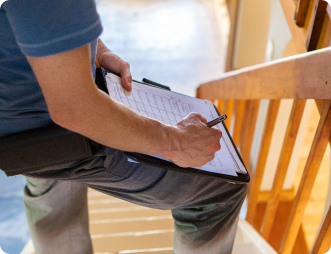What it is
A PDI is a thorough walk through led by your builder. It is one of your first opportunities to view your completed home or condo unit before you take possession.
How it works
Your builder will guide you through a comprehensive inspection, explaining how to operate the home’s systems such as the ventilation, plumbing and heating. The objective of this inspection is to record all items that are incomplete, damaged, missing, inaccessible or not operating properly, and noting them on the builder’s PDI Form to verify that these conditions existed prior to occupancy.
Who it protects
Either yourself or a designate must be present during the PDI. When the inspection is over, you or your designate will be asked to sign the PDI Form. It is very important that you understand how to operate your home’s systems because not using them properly could affect your warranty coverage.
Your builder's responsibilities
It is the builder’s responsibility to explain how the various systems in your home work – including the heating, electrical, plumbing and air conditioning. It is also your builder’s responsibility to complete and the PDI form and the CCP (warranty Certificate).
Preparing for the Pre-Delivery Inspection
It’s important to be prepared for your PDI. Below are some tips for preparing for the Pre-Delivery Inspection, as well as some frequently asked questions.
Using a designate for the inspection
You can have someone accompany you to the PDI or you can send a designate to attend on your behalf. There is no restriction as to whom you may choose to be your designate.
If you intend to send a designate to conduct the PDI in your place, you should provide your builder with written authority to sign the PDI Form. This can be done by filling out the Appointment of Designate for the Pre-Delivery Inspection Form.
The PDI form & Certificate of Completion
During the PDI, your builder will provide a PDI Form that is used to record any items that need attention. The PDI Form serves as the official record of the condition of your home before you move in. After all the items are recorded on the PDI Form, you or your designate shall review and sign it to confirm that the listed items are complete and accurate. You will also be asked to review a Certificate of Completion and Possession (CCP). This document states your home’s enrolment number with Tarion and the date of possession, which is also the start date of your statutory warranty. Your builder will give you copies of the completed PDI Form and CCP for your records.
What to look for during the inspection
During the PDI, you should identify any damaged, incomplete, or missing items, as well as anything that is not operating properly or cannot be assessed because it is obscured from view or inaccessible. All such items should be included on the PDI Form.
Be sure to examine both the interior and exterior of the home. While inside, look for things like chips or cracks in tiles, or scratches on countertops or mirrors, damage to floors or walls, and doors and windows that are not secure or do not open and close. When you go outside, check items like the quality of brickwork and siding, whether window screens have been installed, and the appearance of the driveway and landscaping.
Sometimes, due to weather or other factors, you may not be able to inspect a certain item. If you are unable to assess something at the time, simply make note of it on the form. Feel free to take pictures of any damaged or incomplete items. If necessary, those photos can be submitted to Tarion at a later date. You should also note on the PDI Form any unauthorized “substitutions” of items listed in your purchase agreement.
You may want to bring a copy of your purchase agreement for reference. Your builder should note everything down on the PDI Form. Review it carefully, make sure it’s complete and keep a copy. This form will become the official record of the condition of your new home before you moved in.
Tarion may refer to your PDI Form if there is disagreement over whether any damage occurred before or after you took possession.
The Pre-Delivery Inspection for common elements
Condominium Common Elements are not included in the PDI of your unit. The condominium Board of Directors may complete a separate PDI with the builder for all of the common elements. If you see any damage or defects in the common elements, you should notify the Board of Directors so that they can decide whether to record them in a common elements PDI or to take action under the common elements warranty.
What are substitutions
If your purchase agreement gave you the right to select certain items of construction or finishing, such as colours and styles, these usually cannot be substituted without your written consent. In addition, if your purchase agreement states that your new home will include particular items (such as a certain model of appliance, or a specific brand of window) but does not give you the right to make a selection, then such items can only be substituted with items of equal or greater quality.
If you think that an unauthorized substitution has occurred, it should be noted in the PDI Form. If you are unsure about your rights regarding unauthorized substitutions, you may wish to seek the advice of a lawyer.
What to do if you don't identify a problem during the inspection
The PDI provides an opportunity to record your home's condition before you move in. Any issues should be noted on a PDI Form and ideally your builder will correct them right away. The PDI Form does not represent a request for warranty service, so if you fail to note an item this does not necessarily impact your warranty coverage. However, the PDI Form is a useful piece of evidence if you have a conciliation inspection: if the problem concerns a damaged or missing item, it may be difficult to establish that this condition existed before you moved in if it is not noted on the PDI Form.
If when you take possession you notice a damaged or missing item that was not noted on your PDI Form, document and report the condition immediately by, for example, taking photographs and sending an e-mail to your builder. This record will assist in establishing that the condition existed when you took possession of your new home.
Any items that are not corrected by the time you move in need to be listed on a 30-Day or Year-End Form. These forms represent a request for warranty service and listed items that are covered under warranty must be addressed by your builder within a specific timeframe.
Preparing for the inspection with the PDI Checklist
You may wish to print a copy of the Tarion PDI Checklist to help guide you through the process.



